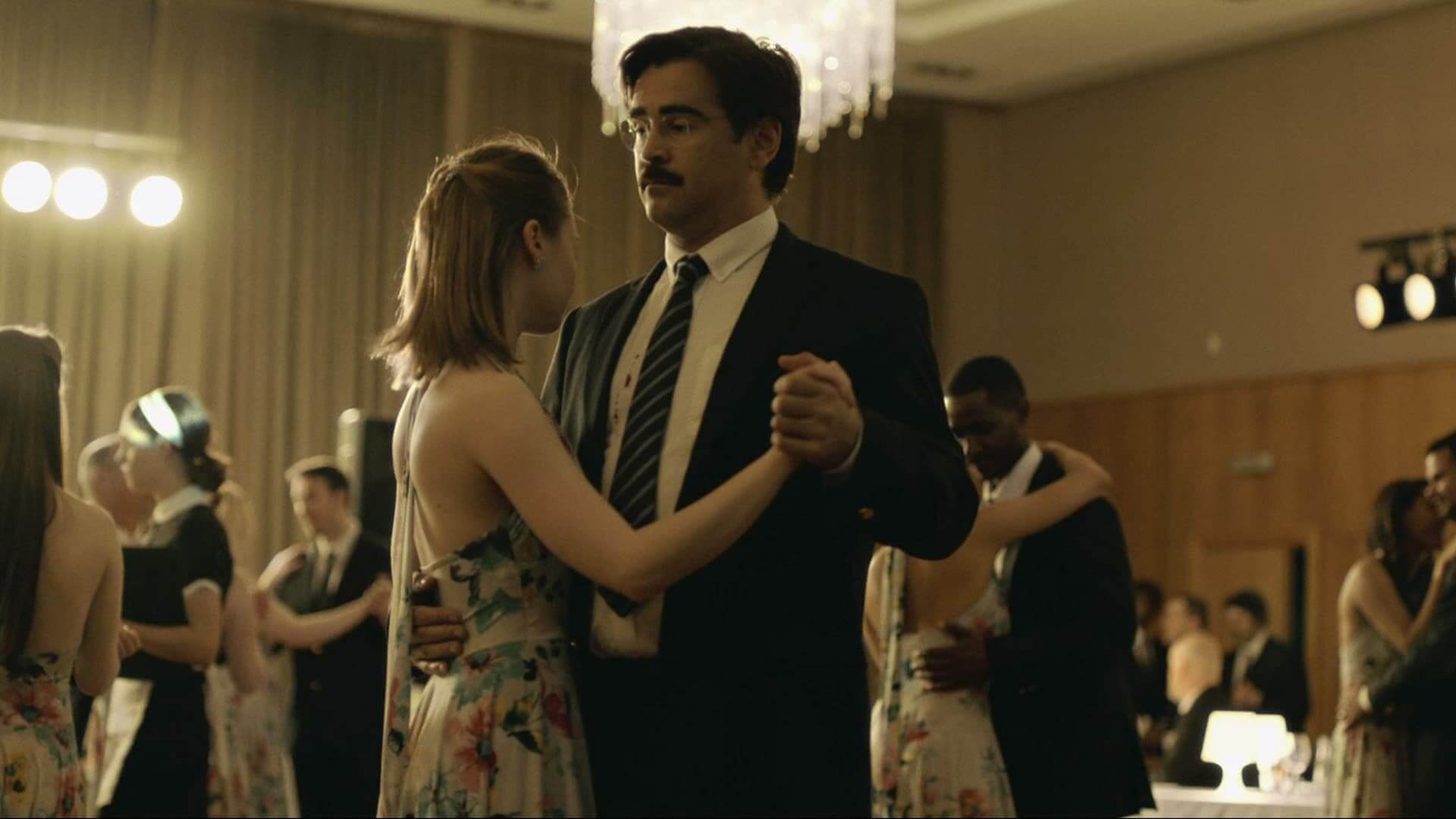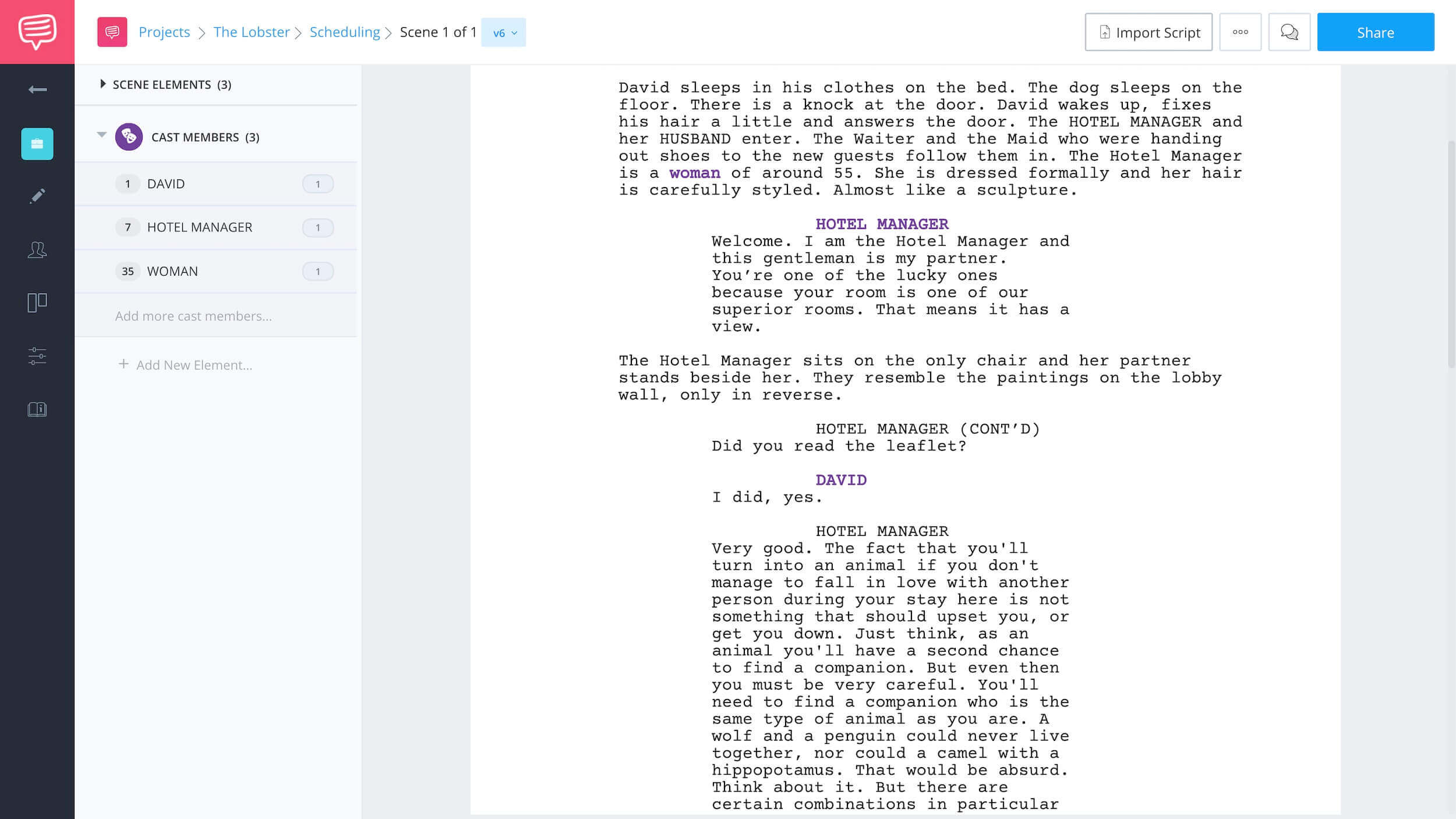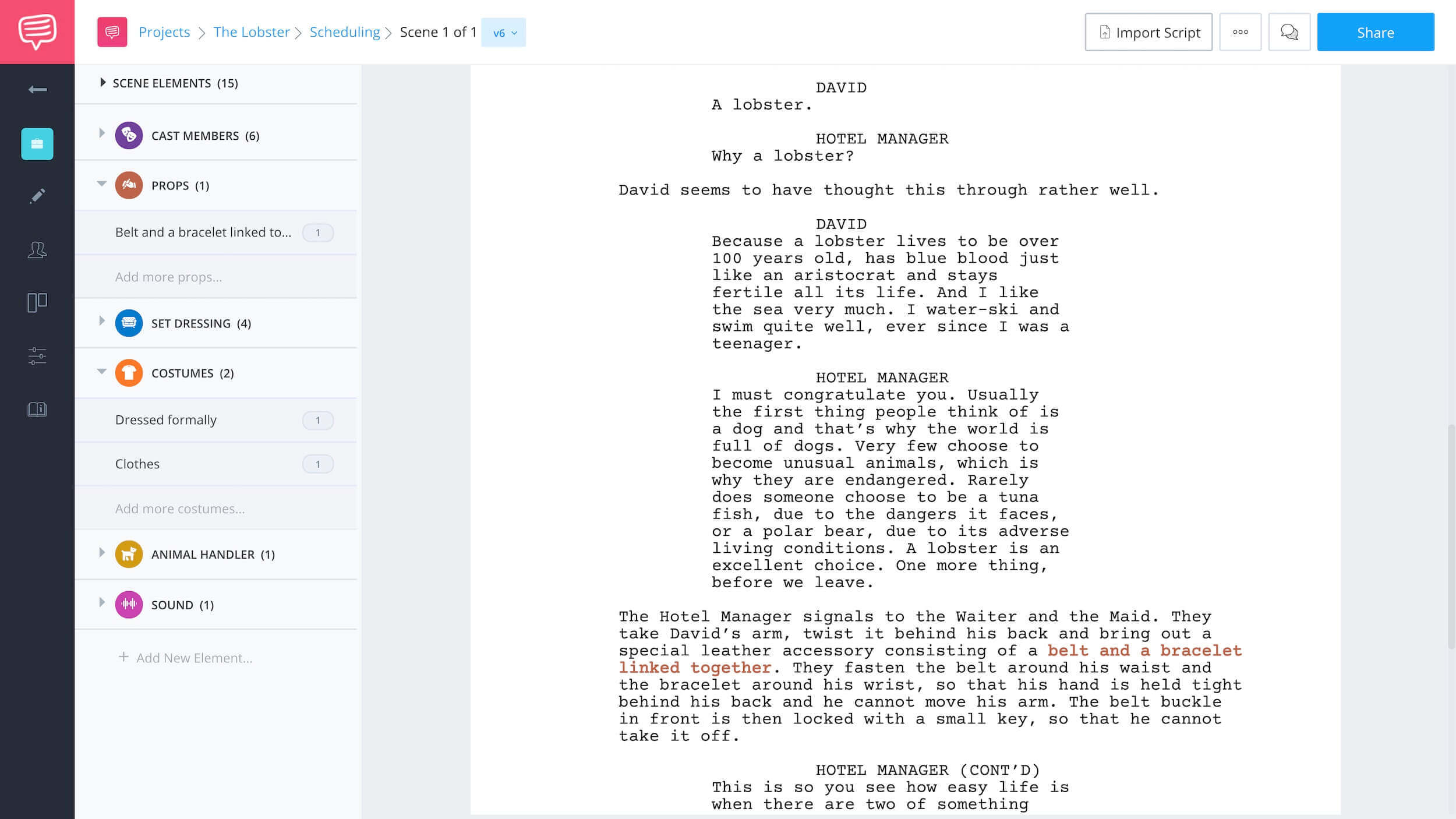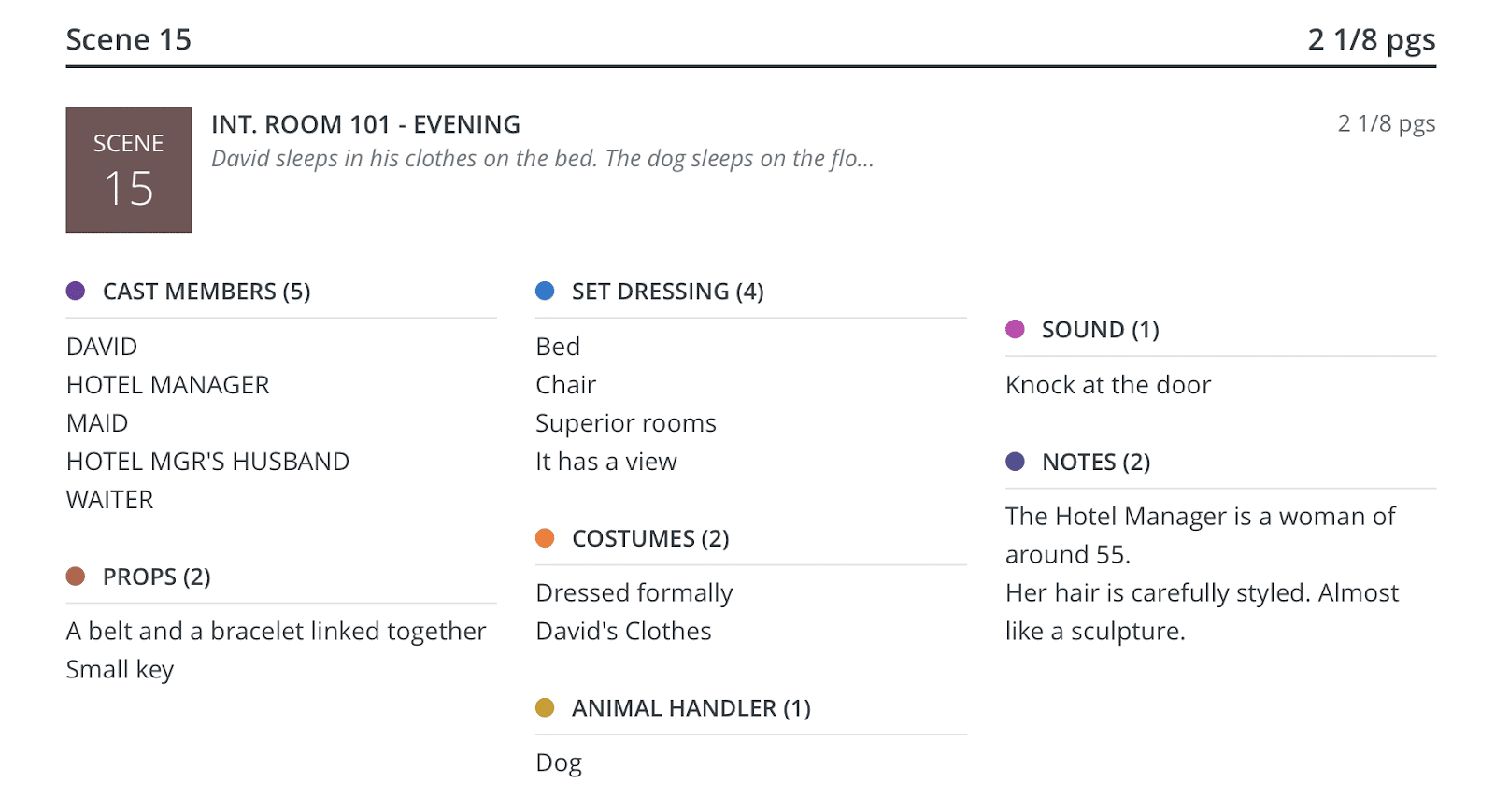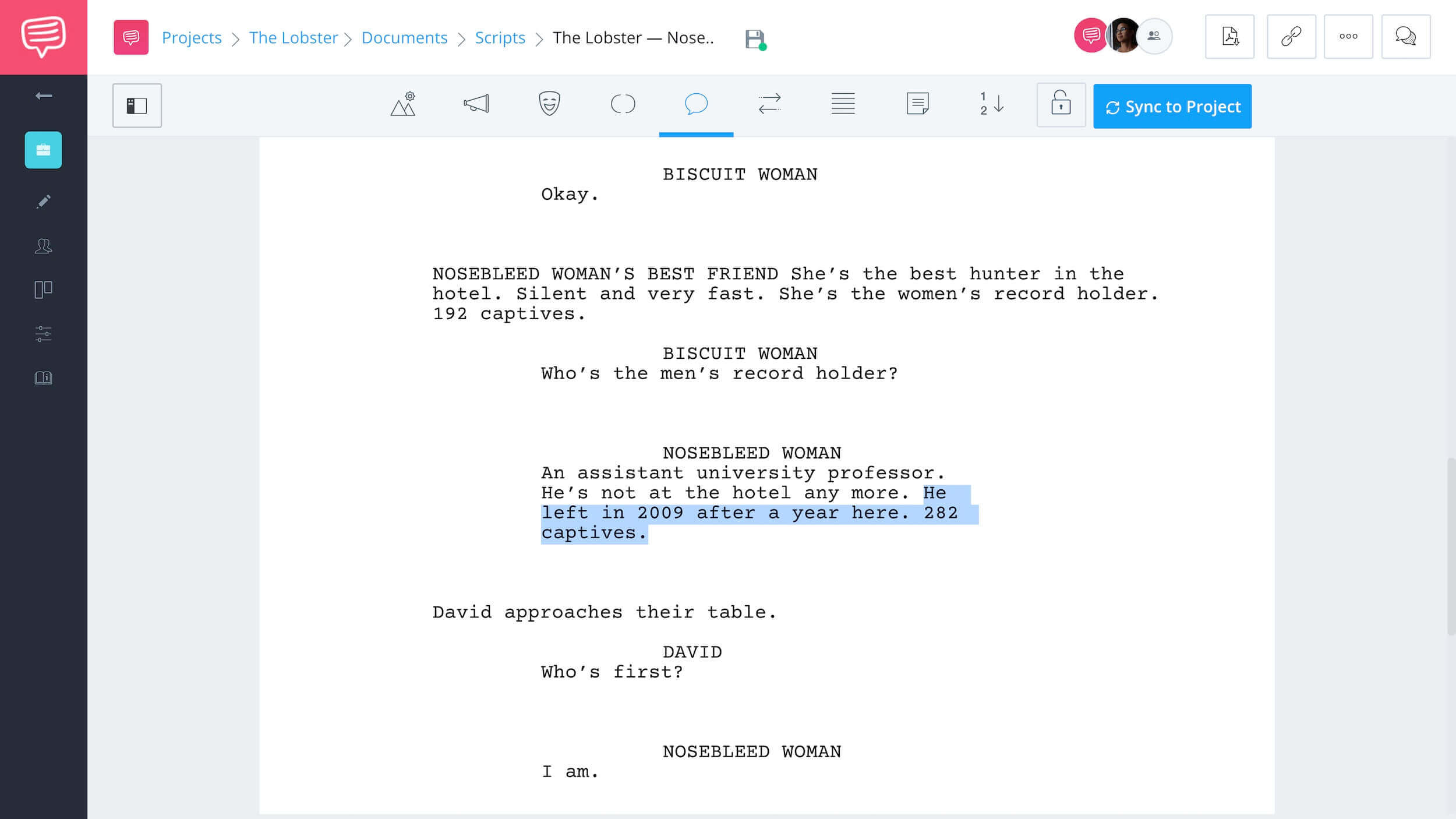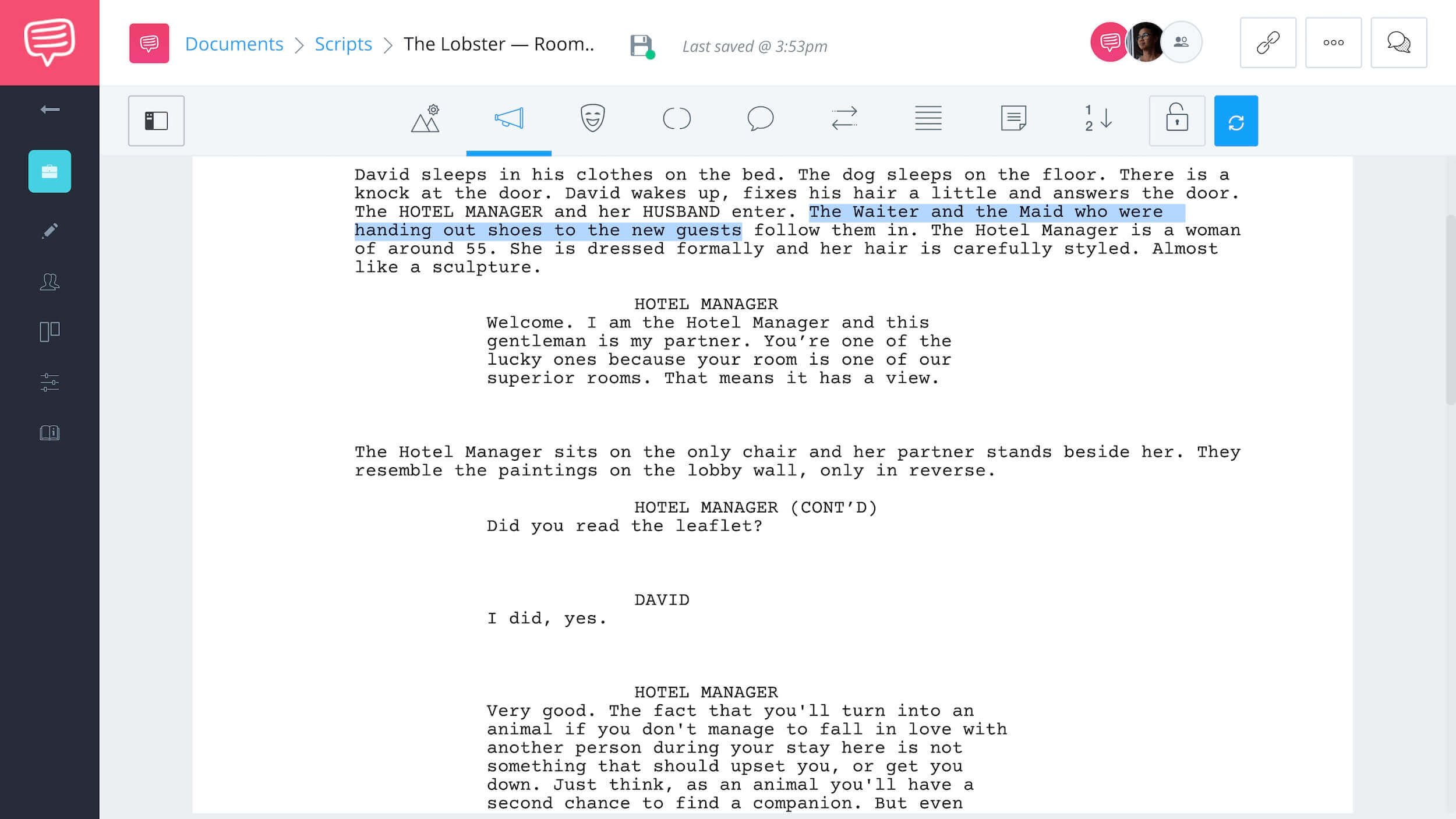There’s an old film school thought experiment that asks about a character, “What does he have in his refrigerator?” In this post, we’re going to practice that experiment.
We can learn plenty about who a character is from the things they say, as well as the things others say about them. But we also learn who a character is by scores of other little details in the text of the script.
Now we’re going to talk about how to actually use the Breakdown Summary, along with the text of the script itself, to flesh out who a character is from the perspective of Costumes and Set Decoration.
The Breakdown Process
Breakdown summary
First, let’s quickly recap the breakdown process. The Line Producer or Assistant Director goes over the entire script, tagging all the elements in each individual scene.
Once that’s done, she’ll use the script breakdown to generate several reports that she’ll send on to each production department. One of those reports is the Breakdown Summary.
Script Breakdown Overview
The Breakdown Summary is the report that lists all the elements from each department needed for each scene in the script. This will serve as a reference for us as we consider what the character might wear, what hairstyle they might have, or what kind of car they might drive.
Character Analysis
Use the breakdown summary
The Breakdown Summary will get us started on sussing out who our character is, but ultimately it is only a list. Even so, a lot of information about a character can be gleaned from it - especially when the screenwriter is specific in the details they provide in the script.
A good example of this can be found in The Lobster, written by Yorgos Lanthimos & Efthimis Filippou. The story is a dark romantic comedy set in a dystopian world where it is illegal for adults to be single.
It opens with David quietly crying about having just been dumped by his wife. We next see David checking in to The Hotel, a mandatory facility where single people must find a partner within 45 days or else be transformed into an animal of their choosing (e.g., a lobster).
The bulk of the story follows an increasingly desperate David as he tries to find another wife at The Hotel, with the last act taking place in the nearby forest. This is where all the people who don’t find a partner, but who refuse to become animals, escape to live out their (likely very short) lives as “Loners.”
Let's watch the scene first before go into the script breakdown.
Why a Lobster
In the script for The Lobster the writers have generously provided us with detailed descriptions in almost every scene. That will make it a good one for us to use as practice for character analysis.
Let’s take a look at the scene above as it appeared in the original script.
Scene 15 • Room 101 Scene • See Full Breakdown
Notice how David is the only character who even has a name. All of the other characters are only “named” using some descriptive identifier. The Hotel Manager doesn’t even use her own name when introducing herself. She says only “I am the Hotel Manager.”
This trend continues throughout the script. Characters are named using a description of some prominent trait about them (e.g., Limping Man, Nosebleed Woman) or simply what their role is (e.g., Receptionist).
What might that tell us about David as a person?
Perhaps that he sees other people only in terms of what he can readily identify about them. This makes perfect sense in a world where you are forced to find a partner based solely on that one, ideally shared, characteristic. People who are seemingly “off limits” for mating purposes are identified only by how they function in David’s life.
Notice, too, how even the style of the writing reflects David’s point of view. The descriptions are short and to the point, as if someone is merely taking inventory, rather than actually seeing what’s around them.
Scene 15 • Room 101 Scene (Continued) • See Full Breakdown
What might that tell us about David? Maybe that he zeros in on the details rather than seeing the whole picture because is always calculating how compatible he might be with the person he is engaging with. The more details he can find in common with the other person, the more compatible they are likely to be.
Let’s look a little closer at the action. It tells us that David “sleeps in his clothes on [top of] the bed.” Why might David being doing this? Is he just napping before dinner, or is he depressed?
“The dog sleeps on the floor.” This might not mean much at first glance, but we learn in a scene prior to ours that “the dog” is actually David’s brother who was at The Hotel a few years ago but couldn't make it.
Is it strange that “the dog” doesn’t sleep on the bed with David? Does that say anything about David’s relationship with his brother, or are dogs just not allowed on the bed at The Hotel?
Related Posts
David must have been taking care of his brother since “he didn’t make it” rather than just letting Dog-Brother roam wild in the forest to fend for himself. So, we might conclude that the two were/are close.
What about the lobster being David’s animal of choice? All the things he tells the Hotel Manager he admires about the creature also happen to be the sort of attributes that society has traditionally seen as being superior: long-lived, aristocratic, never infertile.
We could interpret that as David longing to be superior - or at least distinct - from everyone else. Again, in a world where partners are changed almost as easily as a pair of socks, this would make sense.
These are all points to consider as we work out who David is. Now let’s check out how this scene breaks down using StudioBinder's screenwriting software.
Scene 15 • Room 101 Scene • See Breakdown Summary
On its own, the Breakdown Summary might not tell us much. However, we can still glean a certain amount of information from it. For example, we can still see that David is the only character who has a name. We can see that the room is “superior” and “has a view.”
When we go back and look at these elements in context, we get a clearer picture of who David is and his place in his world. So what do we think we can say about David at this point?
- He loves his brother
- He might be depressed
- He longs to be superior to everyone else
- He focuses on details rather than the big picture
How could we apply know about David to his costumes?
Character Analysis
Imagine wardrobe
There’s a reason why costume designers have dozens of books on fashion through the ages: because the first thing we need to think about when considering wardrobe is the time period.
In The Lobster, the script has one specific reference to the year 2009.Scene 27 • Nosebleed Woman Scene • Read Full Scene
Because the script was written in 2013, it would be fair to assume that the story is meant to be contemporary. However, the setting is a parallel world where the technology exists to transform human beings into any other kind of animal.
Being set in a parallel world gives us a bit of flexibility in our wardrobe choices. But being dystopian in tone, there are also certain tropes of the sub-genre that we might want to bear in mind. For instance, dystopian societies tend to dress in simple, plain clothing.
In our story however, we have the added detail of it being a world where people are essentially interchangeable, so we would want the clothing to represent that concept.
We might want there to be a “not exactly the right size for the wearer” aspect to our costuming, for example, or a standardized look worn by everyone at the time.
Look for clues in the text • Read Full Scene
We can infer from the text of our scene that there is a sort of “uniform” that residents of The Hotel are given. But in real life, we would have read the whole script, so we would know that to be the case.
We would then need to think about what that might be. Would men wear one sort of outfit, and women another? Or would everyone wear the same outfit?
These are the kinds of things you need to imagine from the character’s point of view. And whatever we come up with, we would still want our David to have his own look that reflects who he is as a person.
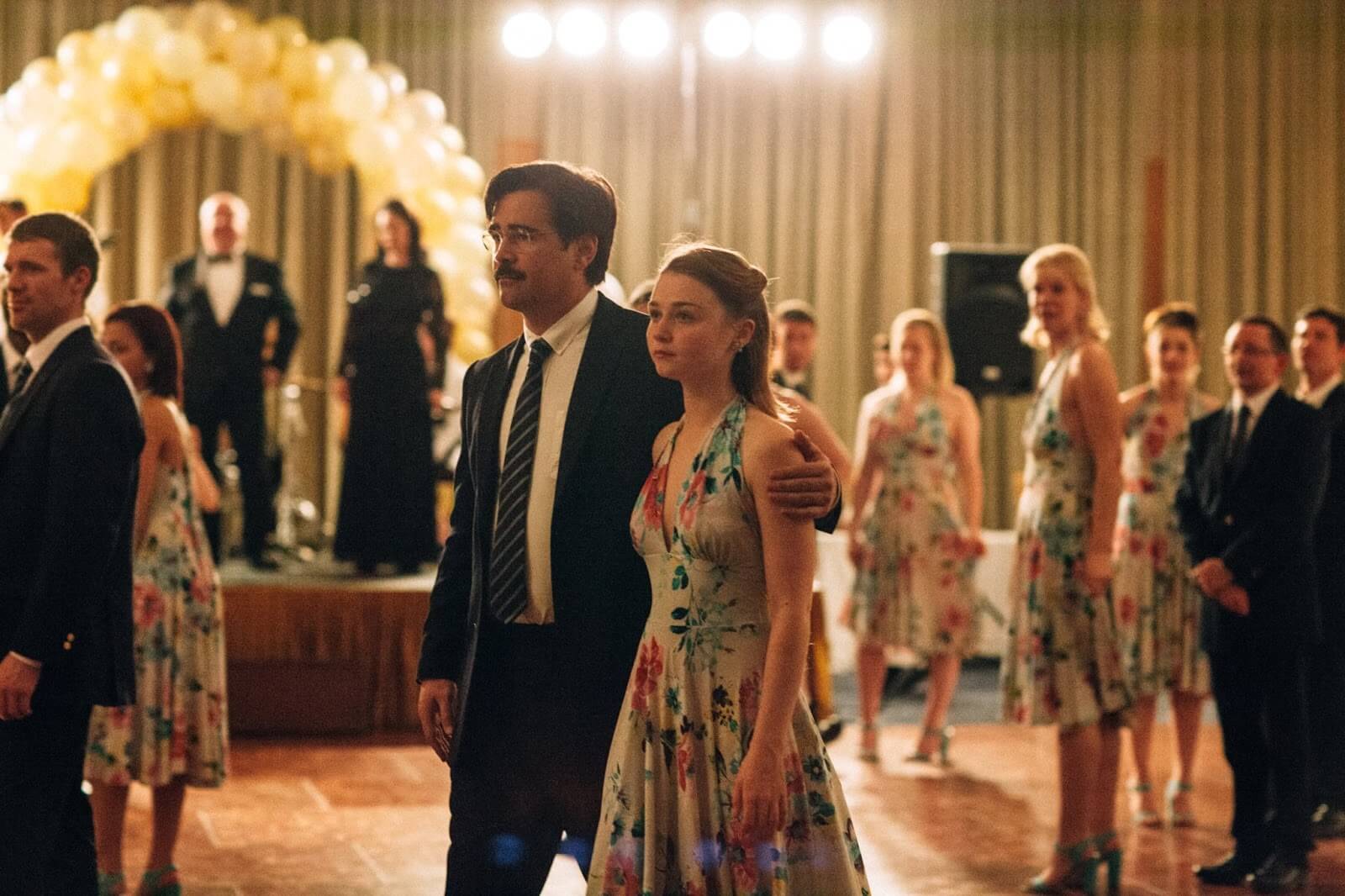
Costumes in The Lobster
Ultimately, though, you would work out all your costuming decisions with the director, based on her vision. We’ll use the same process when considering set decoration.
CHARACTER ANALYSIS
Read the room
Using clues from the text let’s think about what David’s hotel room looks like. We know it is “superior” and “has a view” and that it has a bed and one chair.
What sort of bed would a government facility for single people have? Even in a “superior room”? Would it be a twin bed or a queen? What sort of linens would be on it? Colored sheets or plain, stark white?
What about the chair? Is this a big, chunky, leather wingback affair, or more like something you’d sit in at your doctor’s office? Does it have arms or can you push it under a desk?
All of the wardrobe, props, and set decoration choices for The Lobster were made based on delving into who David is as a person, and understanding his place in the world of the story.
Between the breakdown summary and the original text, you’ll also have the tools to get a strong enough sense of who a character is to be able to come to production meetings prepared with solid ideas.
Now, what do you think David, the Lobster, has in his refrigerator?
Up Next
Free script breakdown sheet
Now that we've broken down the scene from The Lobster, check out our ultimate guide for creating script breakdowns. Then download a free breakdown sheet we've provided just for you, to make your production hassle free!
Up Next: How to Make a Script Breakdown →
Easily create script breakdown sheets online.
Import scripts. Tag elements like props, wardrobe, and cast. Create breakdown summaries and DOOD reports in a snap.
